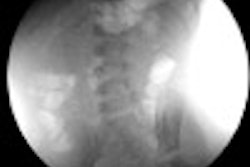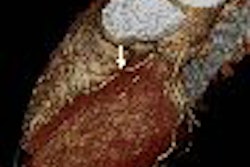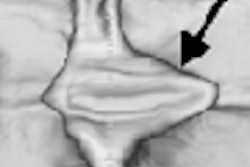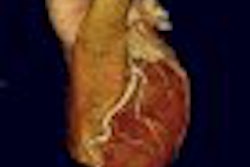Lossy 3D JPEG 2000-compressed abdominal multidetector-row CT (MDCT) studies are visually indistinguishable from the original studies at ratios of 4:1 and 8:1, according to research from the Medical University of Vienna in Austria.
"At ratios of 12:1 and 16:1, readers could easily find the original within the pair," said Dr. Helmut Ringl. He presented the team's research during a scientific session at the 2006 RSNA meeting in Chicago.
To assess the effect of lossy 3D JPEG 2000 compression on the quality of emergency abdominal CT images, and to determine the ratios at which compressed abdominal CT images can be distinguished from the original study, the researchers performed a retrospective review of 60 patients with emergency abdominal CT exams. The patients included 31 men and 29 women with a mean age of 50.8.
CT scans were obtained using a Sensation Cardiac 64 scanner (Siemens Medical Solutions, Malvern, PA), and reconstructed with 3- and 6-mm slice thicknesses. 3D JPEG 2000 lossy wavelet compression (Aware, Bedford, MA) was applied using compression ratios of 4:1, 8:1, 12:1, and 16:1.
From each study, one case-relevant compressed image was selected for each slice thickness and paired with the original image. A total of 300 image pairs for 3 mm and 300 image pairs for 6 mm thickness were evaluated.
Three radiologists then independently evaluated the image pairs on a PACS workstation by toggling back and forth between the original and compressed image. The order of the pairs was randomized and blinded to the readers.
Readers were forced to determine the original image using a "forced-choice, two-alternative model," Ringl said. After deciding which one was the original image, the readers were then asked to rank the compressed images for image quality using a ranking of either A (identical), B (minimal compression artifacts, allowing determination of the original images), or C (considerable artifacts).
The researchers found that images compressed at a ratio of 4:1 were indistinguishable from the original image for all readers (P > 0.081). For the 8:1 ratio, two readers found compressed images not to be significantly distinguishable from the original studies, although one could identify the original image in a significant number of cases (P < 0.039).
All readers were able to recognize the original images at the 12:1 and 16:1 ratios (P < 0.001), according to Ringl. There were no differences between the 3- and 6-mm slice thicknesses.
The ratios of 4:1 and 8:1 were visually indistinguishable from the original study, while ratios of 12:1 yielded minor artifacts and were clearly distinguishable from the original exam, Ringl concluded. But there were "considerable" artifacts at a ratio of 16:1, he noted.
By Erik L. Ridley
AuntMinnie.com staff writer
February 23, 2007
Related Reading
Canadian radiologists pursue lossy compression research, February 16, 2006
Image compression method may make large mammo datasets more manageable, December 22, 2005
Lossy compression wins over Canadian radiologists, July 21, 2005
3D JPEG 2000 compression shines in multislice CT data, February 9, 2005
Copyright © 2007 AuntMinnie.com



















